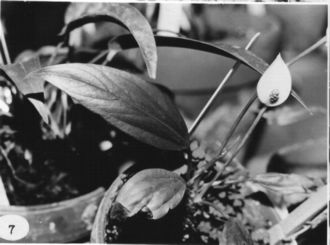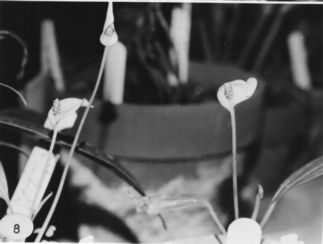





Anthurium amnicola Dressler,
Anthurium lilacinum Dressler, Selbyana2: 300. 10 Jan. 1979 (Dec. 1978), non Bunting, Dec. 1975. TYPE: Panama. Col—n: along tributary between Cano Rey and San Lucas, S of Code del None, 19 Aug. 1972, on boulders, 1.5-2 m above river, Dressler 4210 (US, holotype; MO, PMA, SEL, isotypes).
LEAVES erect-spreading; petioles 6-11 cm long, subterete, shallowly sulcate adaxially; geniculum 1-2 cm long, inconspicuous; blades subcoriaceous, semiglossy, elliptic to elliptic-lanceolate, gradually acuminate at apex, narrowly acute to rarely obtuse at base, 7-14.5 cm long, 1.2-3.7 cm wide, usually broadest near the middle; upper surface sparsely and incon-spicuously glandular-punctate; lower surface epunctate; midrib acutely raised above and below, sunken toward apex above; basal veins 1-2 pairs, weakly sunken; primary lateral veins 3-4 per side, more or less obscure; collective vein arising from the first basal vein, 3-4 mm from the margin.
INFLORESCENCE erect; peduncle terete, 6÷26 cm long; spathe subcoriaceous, pale lavender (B & K Purple 6/5), ovate, 2.6-4.2 cm long, 1.5-2.2 cm wide, abruptly acuminate to cuspidate at apex, rounded to attenuate at base, inserted at 45° angle on peduncle; stipe 3-7 mm long; spadix violet purple, tapered toward apex, 0.8-2 cm long, 4÷5 mm diam., flowers rhombic to more or less 4-lobed, 1.9-2.2 mm long, 3-3.2 mm wide, inner margins more or less straight; pistil weakly raised; stigma linear, ca. 0.4 mm long; lateral stamens emerging first, the alternates following slowly; anthers white, ca. 0.6-0.7 mm long, 1 mm wide, held at edge of tepals; pollen white.
INFRUCTESCENCE with globose, whitish berries, 4÷4.5 mm diam., mesocarp gelatinous; seeds 1-2, green, ovoid, slightly flattened, 2.5-3 mm long, 2-2.5 mm wide. Figs. 7 and 8.
Anthurium amnicola is endemic to Panama at 600 to 900 m in western Col—n and Code Provinces in areas of premontane rain or tropical wet forest.
The species is a member of section Porphyrochitonium, and as the specific epithet suggests it is found only on rocks in or along rapidly flowing mountain streams. It is distinguished by its small size, its narrowly oblong-elliptic, gradually acuminate leaves that dry pale and are only obscurely glandular-punctate, and especially by its narrowly to broadly ovate, pale lavender spathe and short, stubby, dark violet purple spadix and whitish berries. The species is unusual in being weakly glandular-punctate only on the upper surface. Even these punctations are not markedly apparent to the naked eye.
Anthurium amnicola is most closely related to A. antioquiense Engl. of northern Colombia, which has a similar habitat and habit and similar epunctate leaf blades. The latter species differs in having a white spathe and lavender spadix. Anthurium amnicola is not confused with any other species in Panama, although its habitat and leaf blades are similar to those of A. sytsmae. That species diners in having a green lanceolate spathe, a green spadix, and green fruits. Anthurium rupicola also occurs on rocks in streams in Code Province, but it diners in having a green, lanceolate spathe, white spadix, and violet purple berries.
 |
 |
CoclŽ Alto Calvario, Folsom 3155 (MO, RSA, SCZ), 5900 (MO);
Vicinity El Copé, António 3620 (MO, PMA), Folsom 3265
(CAS, F, MO, SEL, US), 4941 (DUKE, GH, MO), 8280, 8637 (MO),
Folsom & Collins 6517 (MO, NY, PMA, RSA, SEL, US), Hammel
809, 2366, 4116 (MO), Maas et at. 2724 (MO, U);
El Valle Market, near La Mesa, Folsom 2664 (MO).